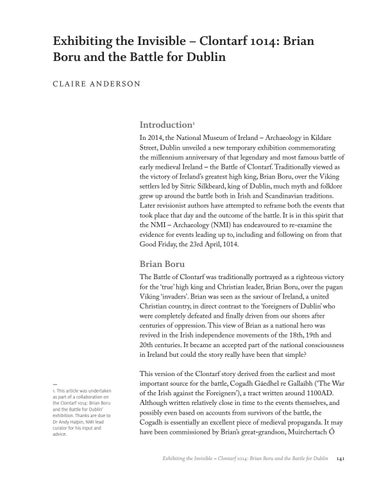Exhibiting the Invisible – Clontarf 1014: Brian Boru and the Battle for Dublin CLAIRE ANDERSON
Introduction1 In 2014, the National Museum of Ireland – Archaeology in kildare Street, Dublin unveiled a new temporary exhibition commemorating the millennium anniversary of that legendary and most famous battle of early medieval Ireland – the Battle of Clontarf. Traditionally viewed as the victory of Ireland’s greatest high king, Brian Boru, over the Viking settlers led by Sitric Silkbeard, king of Dublin, much myth and folklore grew up around the battle both in Irish and Scandinavian traditions. Later revisionist authors have attempted to reframe both the events that took place that day and the outcome of the battle. It is in this spirit that the NMI – Archaeology (NMI) has endeavoured to re-examine the evidence for events leading up to, including and following on from that Good Friday, the 23rd April, 1014.
Brian Boru The Battle of Clontarf was traditionally portrayed as a righteous victory for the ‘true’ high king and Christian leader, Brian Boru, over the pagan Viking ‘invaders’. Brian was seen as the saviour of Ireland, a united Christian country, in direct contrast to the ‘foreigners of Dublin’ who were completely defeated and finally driven from our shores after centuries of oppression. This view of Brian as a national hero was revived in the Irish independence movements of the 18th, 19th and 20th centuries. It became an accepted part of the national consciousness in Ireland but could the story really have been that simple?
— 1. This article was undertaken as part of a collaboration on the Clontarf 1014: Brian Boru and the Battle for Dublin’ exhibition. Thanks are due to Dr Andy Halpin, NMI lead curator for his input and advice.
This version of the Clontarf story derived from the earliest and most important source for the battle, Cogadh Gáedhel re Gallaibh (‘The War of the Irish against the Foreigners’), a tract written around 1100AD. Although written relatively close in time to the events themselves, and possibly even based on accounts from survivors of the battle, the Cogadh is essentially an excellent piece of medieval propaganda. It may have been commissioned by Brian’s great-grandson, Muirchertach ó
Exhibiting the Invisible – Clontarf 1014: Brian Boru and the Battle for Dublin
141













